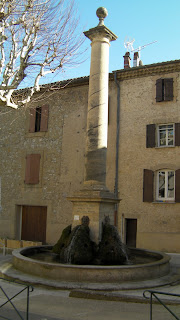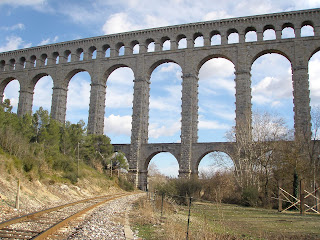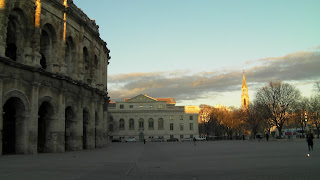On Jan 20, Christine and I went to Ventabren in search of the Roquefavour aqueduct. The Roquefavour aqueduct is the largest stone aqueduct in the world. Seeing as we have not been having great luck with Aqueducts, we thought we'd try again, but with an in-service, big aqueduct...surely we would find that..
After finding a parking place to wedge the car into we walked to the top of the ventabren hill, and found the city centre, with a lovely old church and a coblestone square.
Around the corner from the church cemetery are the remains of a castle that used to be home to the Count of Provence, which dates from 980 AD. I like the arrow slits to keep the travelling salesmen away!
Lovely view from the castle, looking down on the church, and the valley below.
Aqueduct? is that you? Nope TGV line ... modern day peopleduct.
A picturesque little building on the main square. Lets see if Ken the GPS knows where this largest in the world aqueduct is. On a side note, if you have something really big, and you need to hide it....give the good people of Ventabren a call I am sure they can help.
Et Voila, put it behind some trees did you...
The Roquefavour aqueduct is a triple arch affair, 400m long, and 83m high. While not a Roman construction, it is still older than Canada, built between 1841 and 1847, the aqueduct is still in service, bringing water from the Durance river to Marseille.
Closer....
Look up, look waaayyy up.
On Saturday the whole gang headed off to Nimes. Nimes was founded in about 28BC (at least as a colony of Rome), and represents our first trip to the Languedoc region of France. The coat of arms of Nimes is a crocodile chained to a palm tree, representing Rome's conquest of Egypt. Apparently if you were a lucky enough to live long enough to retire from the Roman legions (15 yrs service) Julius Caesar would grant you a plot of land in Nimes. The croc below is on a bollard on the sidewalk (used to keep the cars from parking there)
Nimes has a very beautiful main water course, a statue of Augustus at one end, and spring-fed fountains and gardens at the other end.
One of the main attractions that we came to see if the very well preserved 1st century AD coliseum. This thing was much easier to find than the aqueduct. The coliseum is still in use today for various activities from concerts to bull fighting.
Looking down from the nose-bleed section to the arena below - can you see the gladiators?
Our two gladiators..
The coliseum is very impressive.
From the car window with the late afternoon sun
One of the clock towers in Nimes, as seen through a window/portal of the coliseum.
The Maison Carree (Lit Square House) a roman temple, from 19BC, originally dedicated to sons of Augustus.
On top of a hill stands the remnants of a stone tower called the Tour Magne. The tower originally formed part of the walls of the city and served as a watch-tower / look at how powerful we Romans are tower.
You can go up inside the tower and reach an observation platform at the top.
Below the tower are the public gardens and fountains, laid out in the mid 1700s. The vegetation includes lots of palm trees, but alas, no crocodiles.
more of the gardens.
To the side of one of the gardens is the temple of Diana.
OK MOM AND DAD, I'm hungry. We find a small street vendor of crepes and frites and refill prior to the drive home

.JPG)
.JPG)






















































